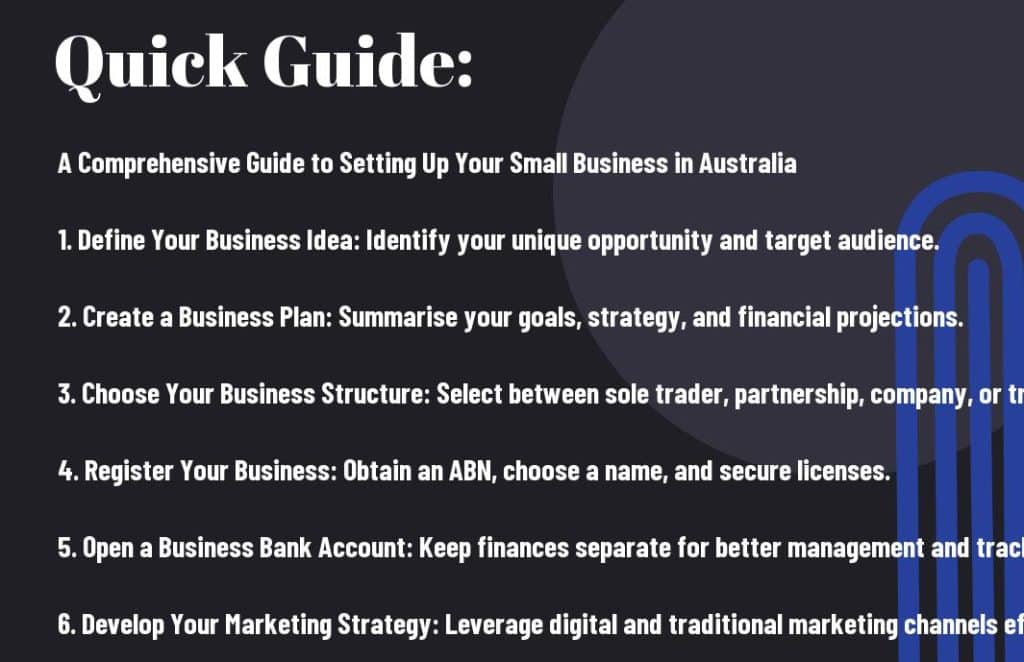Understanding the Australian Business Environment
Australia boasts a vibrant and diverse business landscape that supports various types of enterprises. Understanding the array of business types can help you determine the ideal model for your venture.
Overview of Business Types in Australia
| Business Type | Description |
| Sole Trader | An individual operating their own business, responsible for all aspects. |
| Partnership | A business owned by two or more individuals who share profits and responsibilities. |
| Company | A legal entity separate from its owners, offering limited liability protection. |
| Trust | A structure where a trustee manages the business assets on behalf of beneficiaries. |
| Co-operative | A business owned and run by its members for mutual benefits. |
- Exploring your options is vital for choosing the right business structure.
- Evaluating the legal and tax implications can save you time and money.
- Perceiving the characteristics of each type will support your decision-making process.
Key Economic Factors Influencing Small Businesses
For small business owners in Australia, understanding key economic factors is important to making informed decisions. These factors directly impact your operational landscape and growth potential.
- Current economic growth rates.
- Consumer confidence and spending patterns.
- Access to finance and interest rates.
- Employment rates and wage growth.
- Inflation and external trade conditions.
For instance, the Australian economy grew by approximately 4.2% in 2021, spurred by government stimulus and consumer spending. Lower interest rates also mean that borrowing is more accessible for small businesses, enabling investment and expansion. However, you should stay abreast of potential inflation and changes in the global economic landscape, as these factors can significantly influence your operations. Recognising these economic trends will ensure that your business remains agile and competitive.
Analyzing Industry Trends and Opportunities
An important aspect of setting up your small business is analysing industry trends and identifying opportunities for growth. Awareness of emerging trends can guide your strategic decisions.
Businesses that adapt quickly to shifts in consumer preferences and technological advancements often enjoy a competitive edge. Keeping an eye on industry reports and market analyses can provide insights into the demands of your target audience. Additionally, recognising the potential benefits of online platforms and e-commerce will help you optimise sales channels and customer engagement. By harnessing these opportunities, you can position your business for long-term success.
Key Takeaways:
- Thorough planning is vital. A solid business plan can increase your chances of success significantly. Research indicates that businesses with a formal plan are 16% more likely to achieve their goals (Source: Small Business Administration).
- Choosing the right business structure is imperative, as it impacts your tax obligations and personal liability. In Australia, approximately 58% of businesses operate as sole traders, making it the most common structure, but each option has unique pros and cons (Source: Australian Bureau of Statistics).
- Securing necessary registrations, such as an Australian Business Number (ABN) and GST registration, is mandatory. More than 3.4 million ABNs were registered by the end of 2021, highlighting the importance of compliance in establishing your business (Source: Australian Taxation Office).
- Investing in the appropriate financial management tools can enhance operational efficiency. Around 30% of small businesses reported that using accounting software improved their cash flow management (Source: QuickBooks).
- Effective marketing strategies, both digital and traditional, are key to growth. Statistics show that small businesses that leverage digital marketing see 60% more leads than those that do not (Source: HubSpot).

Essential Preparations for Starting a Business
Even the most innovative business idea requires sound preparation to transform into a successful venture. Preparing effectively involves identifying your key goals, understanding your marketplace, and ensuring you have all necessary information at your fingertips. In this section, we’ll explore important steps to lay the groundwork for your small business launch in Australia.
Identifying Your Business Goals and Objectives
Little decisions made today can have a significant impact on your future business success. Clearly defining your business goals and objectives will provide you with a roadmap to guide your actions. Establishing specific, measurable, achievable, relevant, and time-bound (SMART) goals is necessary for tracking progress and steering your business in the right direction.
Conducting a SWOT Analysis
Business success often relies on understanding your environment, which is where a SWOT analysis comes in. Conducting this analysis involves evaluating your business’s Strengths, Weaknesses, Opportunities, and Threats, offering a comprehensive overview of where you stand in the market.
With a SWOT analysis, you assess what advantages you bring to the table, identify internal shortcomings, and discover external opportunities for growth or innovation. This structured reflection not only helps you strategise effectively but also positions you to address potential challenges proactively. This foundational exercise can lead to a more resilient business approach, preparing you to respond to market dynamics and consumer needs.
Gathering and Organising Necessary Information
Essential information forms the backbone of your business strategy. Gathering and organising data about your industry, competitors, and target audience will empower you to make informed decisions. Begin by compiling relevant market research, customer demographics, and existing competitor analyses to shape your approach.
Conducting comprehensive research involves sourcing industry reports, academic publications, and government databases such as the Australian Bureau of Statistics. This data should be organised in a way that’s easy for you to reference when drafting your business plan or approaching potential investors. The more informed you are, the better positioned you’ll be to navigate the competitive Australian business landscape and seize opportunities for growth.
Types of Business Structures in Australia
Many aspiring entrepreneurs in Australia struggle with choosing the right business structure. Each structure has its own advantages and disadvantages that can impact how you manage your business, your tax obligations, and your personal liability. Understanding these options can help you make an informed decision that aligns with your goals. Below, you will find common types of business structures summarised in an easy-to-read table:
| Business Structure | Description |
|---|---|
| Sole Trader | Owned and operated by one individual, providing complete control and simplicity. |
| Partnership | Owned by two or more individuals, sharing profits, losses, and responsibilities. |
| Company | A separate legal entity, providing limited liability protection to its owners. |
| Trust | A legal arrangement where a trustee holds assets for the benefit of beneficiaries. |
| Co-operative | A business owned and operated by a group of individuals for their mutual benefit. |
The choice of business structure should reflect your long-term objectives, financial goals, and risk tolerance.
Sole Trader: Pros and Cons
Even though operating as a sole trader is the simplest structure, it comes with its own set of advantages and disadvantages. You enjoy full control over your business and can make decisions quickly. However, you are personally liable for all debts, which can pose significant risks. Below are the pros and cons summarised:
Pros and Cons
| Pros | Cons |
|---|---|
| Easy to set up | Unlimited personal liability |
| Full control | Harder to raise funds |
| Simplified tax reporting | Limited growth potential |
| Less regulatory burden | Potential for burnout |
| Tax benefits on losses | All profits taxed as personal income |
Partnership: Advantages and Disadvantages
Clearly, a partnership allows you to pool resources and collaborate with others, making it a popular choice for various professional services. You can share the workload and costs while retaining a degree of flexibility in management. However, partners can be held liable for each other’s actions, which adds an element of risk. Understanding these dynamics is crucial for making the right choice.
This collaborative model also necessitates clear communication and trust among partners to avoid disputes and ensure smooth operations. Partnership agreements can help define roles, profit-sharing, and responsibilities to minimise misunderstandings.
Company vs. Trust: A Comparative Review
For those considering more complex business structures, understanding the differences between a company and a trust is important. Below is a comparison that highlights these key distinctions:
Key Comparisons
| Company | Trust |
|---|---|
| Separate legal entity | Not a separate legal entity |
| Limited liability for shareholders | Liability depends on trustee’s actions |
| More regulatory compliance | Less regulatory oversight |
| Perpetual succession | Ends when the trust is dissolved |
| Taxed at a corporate rate | Taxed on income distributed |
Types of business structures serve different purposes, and selecting one that meets your specific needs is fundamental for ensuring long-term sustainability. Consulting with a financial advisor can provide valuable insights tailored to your situation as you explore the right path for your entrepreneurial journey.
Crafting a Robust Business Plan
After identifying a viable business idea and conducting thorough market research, your next imperative step is to create a robust business plan. This document not only serves as a roadmap for your business but also helps you secure funding and guide your operational strategies. A well-crafted business plan can significantly increase your chances of success in the competitive Australian market.
Key Components of a Business Plan
Robust business plans encompass several key components, including an executive summary, detailed market analysis, financial projections, and a clear marketing strategy. Each section should articulate your business goals, outline your target market, and discuss your operational plans. This comprehensive approach ensures that every aspect of your business is addressed and that potential investors or partners fully understand your vision.
Step-by-Step Guide to Writing Your Plan
Now, let’s look at a simple step-by-step guide to writing your business plan, providing you with a clear structure to follow:
| Step | Description |
|---|---|
| 1 | Research your market and industry thoroughly to identify opportunities and threats. |
| 2 | Define your business’s vision and mission to ensure a strong foundation. |
| 3 | Describe your products or services, focusing on their unique value proposition. |
| 4 | Outline your marketing strategy and sales plans to attract and retain customers. |
| 5 | Develop financial projections, including income statements, cash flow statements, and balance sheets for at least three years. |
| 6 | Review and revise your plan regularly as your business evolves and the market changes. |
With this guide, you can methodically build your business plan, ensuring that all critical areas are covered. Each step allows you to refine your ideas and assess the viability of your business model. Remember to involve key stakeholders where necessary, and be open to feedback that could enhance your plan’s effectiveness.
Tools and Resources for Effective Business Planning
Now, various tools and resources can aid you in crafting an effective business plan. Look into business planning software such as LivePlan, Bizplan, or the Australian Government’s Business.gov.au website, which offers templates and guidelines tailored for Australian entrepreneurs.
A wealth of online resources is available to streamline your planning process. You can access free templates, case studies, and financial models that can assist you in constructing a comprehensive business plan. Furthermore, consider leveraging local business advisory services and workshops, which often provide invaluable insights and networking opportunities to enhance your planning efforts.
Legal Requirements for Starting a Business
Unlike many other aspects of running a business, navigating the legal requirements can be particularly complex but is vital to ensuring your venture operates smoothly. Compliance with Australian laws not only protects your business but also builds credibility with customers and stakeholders.
Registering Your Business Name and Domain
Now that you have a business idea, it’s time to secure your business name. By checking the availability of your desired name through the Australian Securities and Investments Commission (ASIC) Business Name Register, you can prevent potential conflicts. Additionally, consider securing a matching domain name to establish a consistent online presence.
Understanding Membership and Licensing Registration
Starting your business may also involve registering for industry-specific memberships and licenses. Many sectors have regulatory requirements that necessitate obtaining specific licenses to operate legally. Failure to secure these could result in fines or loss of business privileges.
Registration for memberships and licenses often varies depending on your industry and locality. It’s crucial to research applicable laws using the Australian Business Licence and Information Service (ABLIS), ensuring that you fulfil all legal obligations and avoid potential penalties while operating your business. For instance, tradespeople often require licensing, which can differ from local council permits for food businesses.
Responsibilities Under Australian Consumer Law
Understanding your responsibilities under Australian Consumer Law (ACL) is crucial for maintaining ethical trading practices. You must ensure that goods and services you provide meet certain standards, while also respecting customers’ rights to refunds and returns.
Under ACL, you are obligated to provide accurate and truthful information about your products or services, refrain from misleading conduct, and honour guarantee rights. This legislation also emphasises the importance of protecting consumer privacy and handling complaints effectively. Adhering to these regulations not only fosters trust with your customers but also shields your business from legal disputes and enhances your reputation in the marketplace.
Financial Setup: Preparing Your Business Finances
Despite the excitement of launching your small business, a solid foundation in financial setup is important. Properly managing your finances will help ensure the longevity and stability of your venture. This involves choosing the right banking options, utilising financial tools, and implementing effective budgeting strategies.
Choosing the Right Business Bank Account
While selecting a business bank account, consider factors such as fees, transaction limits, and access to online banking services. A dedicated business account not only streamlines your finances but also enhances your professional image. Many banks offer tailored accounts that fit your business size and structure, so explore your options carefully to find the best fit.
Overview of Essential Financial Tools
While you’ll need to track your income and expenses accurately, utilising important financial tools can simplify this process. Accounting software like Xero, MYOB, and QuickBooks can automate invoicing, expense tracking, and financial reporting. These tools help you manage your governance efficiently, so you can focus on growth and customer service.
Right from the start, having the right financial tools in place can save you time and enhance accuracy in your operations. By employing accounting software and other financial management resources, you gain insights into your business’s financial performance, helping you to make informed decisions for future growth. Tools like these also ensure compliance with tax obligations, allowing you to focus on your core business activities rather than getting bogged down in financial administration.
Budgeting and Forecasting: Step-by-Step Approach
Now that you have set up your financial tools, the next key aspect is budgeting and forecasting. Maintaining a clear budget helps you allocate resources effectively, while forecasting allows you to predict future revenue and expenses based on various business scenarios.
Budgeting and Forecasting Steps
| Step | Description |
|---|---|
| 1. Set Clear Objectives | Define what you want to achieve financially in the short and long term. |
| 2. Gather Financial Data | Collect historical financial data and market analysis to inform your budget. |
| 3. Create the Budget | List all income sources and expenses, using your financial tools for accuracy. |
| 4. Monitor and Adjust | Regularly review your budget against actual performance to make necessary adjustments. |
Understanding budgeting and forecasting creates a roadmap for your small business’s financial health. Establishing and following a budget empowers you with insights into your spending habits and allows you to anticipate future financial needs. By regularly updating your forecasts based on market changes and internal performance, you position your business to adapt and thrive. Consider consulting resources from the Australian Government or professional financial advisors to help crystalise these strategies effectively.
Taxation and Accounting Guidelines
Keep track of your financial responsibilities to ensure your small business thrives in the Australian landscape. Navigating taxation and accounting can be complex, but understanding the requirements will help you remain compliant and avoid any potential penalties.
Understanding Your Tax Obligations
With various taxes applicable to small businesses in Australia, it’s important to comprehend your obligations. Key taxes include income tax, Goods and Services Tax (GST), and Pay As You Go (PAYG) withholding. Knowing which taxes apply to your business structure can prevent costly mistakes and aid in effective financial planning.
Registering for GST and PAYG Withholding
PAYG withholding is a system where you deduct tax from payments made to your employees and remit it to the Australian Taxation Office (ATO). If your business’s annual turnover exceeds $75,000, you must register for GST, adding 10% to most sales and allowing you to claim credits for GST paid on business purchases.
Taxation responsibilities may vary depending on your business structure and revenue. If your annual turnover exceeds the GST threshold, it’s imperative to register for GST. Additionally, implementing a PAYG withholding system ensures that you withhold the correct amount of tax from your employees’ wages, helping you manage your tax obligations effectively.
Hiring an Accountant vs. DIY Accounting
Registering for accounting services can simplify your financial management. While DIY accounting may save costs initially, you may overlook critical aspects of tax compliance and financial planning. An accountant can provide personalised insights and keep your financial affairs in order, freeing you to focus on your business’s growth.
Obligations related to taxation and accounting can become overwhelming, especially for small business owners. Hiring a qualified accountant can alleviate stress as they bring their expertise to handle your bookkeeping, ensure compliance with tax laws, and provide valuable advice tailored to your financial situation. This can ultimately lead to better decision-making and sustained growth in your business.
Business Insurance: Protecting Your Investment
Your business is an investment of time, money, and passion, and ensuring its protection through appropriate insurance is vital to safeguard your interests. Business insurance helps mitigate risks associated with unexpected events that could threaten your enterprise. Several types of insurance can offer protection tailored to small businesses in Australia.
Types of Business Insurance Available
- Public Liability Insurance
- Professional Indemnity Insurance
- Workers’ Compensation Insurance
- Product Liability Insurance
- Property Insurance
Assume that you have assessed these various types of insurance to match your business needs for comprehensive coverage.
| Type of Insurance | Coverage Offered |
|---|---|
| Public Liability Insurance | Covers legal fees and claims for injury or damages to third parties. |
| Professional Indemnity Insurance | Protects against claims of negligence or inadequate advice. |
| Workers’ Compensation Insurance | Mandatory insurance covering employee injuries at work. |
| Product Liability Insurance | Covers legal costs from claims related to products sold by your business. |
| Property Insurance | Safeguards against loss or damage to business property. |
Assessing Your Coverage Needs: Tips
Protecting your investment involves evaluating what types of insurance align with your specific business model and potential risks. Consider the following tips to assess your coverage needs effectively:
- Identify the unique risks associated with your business.
- Evaluate the legal requirements for insurance in your industry.
- Consider working with a broker to explore tailored policies.
- Review your coverage regularly to adapt to changes.
Perceiving the extent of your risks will better position you to select the appropriate insurance. Often, a tailored approach ensures comprehensive protection for your investment.
Investment in the right insurance policies is not merely a cost but a strategic decision to protect your business’s future. Coverage options like Public Liability and Professional Indemnity Insurance are important consideration points, as they shield you from potential legal ramifications.
Pros and Cons of Different Insurance Policies
One of the key decisions you’ll need to make is weighing the pros and cons of various insurance policies available to you. Understanding these can help guide your choice and ensure you choose coverage that suits your business operations and risks.
| Insurance Type | Pros |
|---|---|
| Public Liability Insurance | Protects against claims from third parties, enhances business credibility. |
| Professional Indemnity Insurance | Covers legal costs for mistakes in professional services, crucial for consultants. |
| Workers’ Compensation Insurance | Legal requirement, ensures employees are covered for workplace injuries. |
| Product Liability Insurance | Covers costs from product-related claims, protecting your assets. |
| Property Insurance | Covers losses from damage to physical assets, safeguarding investment. |
Plus, it’s important to consider the downsides as well. For example, while Public Liability Insurance offers significant protection, the cost may be high for smaller businesses. Similarly, while Workers’ Compensation is mandatory, it could impact your bottom line if not managed effectively. Balancing these advantages and disadvantages will help you make informed decisions about your business’s insurance needs.
Hiring and Employment Compliance
All small business owners in Australia must navigate the complexities of hiring and employment compliance to foster a responsible workplace. Understanding the differences between employees and contractors, adhering to Fair Work regulations, and maintaining health and safety standards are important elements of a compliant business operation.
Understanding Employee vs. Contractor Relationships
One of the first steps in employment compliance is understanding the distinction between employees and contractors. Employees typically have an ongoing relationship with your business, receiving benefits such as paid leave and superannuation, whereas contractors operate as independent entities, providing services under their own terms. Misclassifying workers can lead to legal repercussions, so it’s important to evaluate the nature of the work relationship carefully.
Fair Work Regulations and Compliance Obligations
Understanding Fair Work regulations is fundamental for your business’s compliance with employment laws. The Fair Work Act 2009 governs the rights and responsibilities of employers and employees across Australia, ensuring fair treatment and entitlements. You must also abide by National Employment Standards (NES) that enforce conditions such as minimum wage, hours of work, and leave entitlements.
Hiring employees means you are not only responsible for compliance with the Fair Work Act but also require awareness of specific industry regulations. This includes keeping accurate records of hours worked, paying the correct wage rates, and providing entitlements. The Fair Work Ombudsman offers additional resources to help you navigate these obligations, reducing the risk of disputes and penalties.
Health and Safety Laws in the Workplace
Employee safety is your responsibility as a business owner. Under the Work Health and Safety Act 2011, you must ensure, as far as reasonably practicable, that your workplace is safe and free from health risks. This includes conducting regular risk assessments and implementing safety protocols to protect your staff.
Safety is paramount and involves proactive measures to create a secure working environment. You should provide adequate training, safety equipment, and immediate reporting procedures for hazards. Regularly reviewing and updating your safety policies in line with the latest regulations not only protects your employees but also fosters a positive work culture and enhances productivity. According to Safe Work Australia, poor workplace safety can lead to significant costs, affecting performance and employee morale.
Establishing Your Business Operations
Not only is the setup of your business operations crucial for day-to-day functioning, but it also lays the groundwork for future growth and success.
Choosing an Optimal Location for Your Business
The location of your business can significantly impact your visibility, customer reach, and overall profitability. Consider factors such as proximity to your target audience, accessibility, and the associated costs of rent or purchase. For instance, home-based businesses can save on overhead, while a commercial space may offer greater foot traffic, which is particularly beneficial for retail operations.
Setting Up Efficient Supply Chains and Logistics
Efficient supply chains are fundamental to the smooth operation of your business, directly affecting your ability to meet customer demand. Establish strong relationships with reliable suppliers and streamline your logistics processes to enhance operational efficiency.
Optimal supply chain management ensures that you have the right products at the right time while minimizing costs. You should consider employing inventory management systems, negotiating supplier contracts, and using local logistics services to expedite delivery times. Keeping communication open with your suppliers will also help you respond swiftly to market changes, thus ensuring your operations run smoothly.
Implementing Technology for Operations Efficiency
The adoption of technology can transform your business operations, making them more efficient and cost-effective. Consider using software for project management, communication, and customer relationship management to stay organised and enhance productivity.
Implementing technology solutions can lead to significant improvements in how you operate daily. For instance, using cloud-based accounting software can simplify your finances, while project management tools can streamline team collaboration. Embracing automation in areas such as inventory tracking or customer service can decrease errors and free up time for you to focus on core business activities, ultimately improving your bottom line.
Marketing Your Small Business
To effectively promote your small business in Australia, a well-defined marketing strategy is crucial for reaching your target audience and driving sales. This chapter outlines various marketing approaches to elevate your brand presence and connect with potential customers.
Creating a Marketing Strategy: Step by Step
Strategy development begins with conducting market research to understand your audience and competitors. This informs your unique value proposition and defines your marketing objectives. Establish a clear budget, choose the right channels, and set measurable goals to ensure your strategy remains focused and effective.
Exploring Digital Marketing Techniques
Small businesses can leverage digital marketing techniques to reach a broader audience more effectively. Implementing SEO strategies, utilising social media platforms, and engaging in email marketing campaigns can significantly enhance your visibility and customer engagement, driving traffic to your website.
Marketing statistics reveal that 70% of small businesses invest in social media marketing, with 50% reporting increased brand awareness through these channels, according to the Australian Bureau of Statistics. By engaging actively on platforms like Facebook and Instagram, you can not only promote your products and services but also build a community around your brand.
Evaluating Traditional Marketing Methods and Their Effectiveness
Even as digital marketing gains prominence, assessing traditional marketing methods remains crucial. You can utilise print advertising, networking events, and public relations to reach local audiences and establish credibility in your community.
Your evaluation should include measuring the return on investment (ROI) for each traditional marketing method employed. According to the Australian Marketing Institute, direct mail campaigns yield an average response rate of 4.9%, highlighting that traditional methods can still provide measurable results when executed thoughtfully alongside your digital strategies.
Building and Maintaining Customer Relationships
For business owners in Australia, cultivating strong customer relationships is vital to sustaining long-term success. Strong relationships not only encourage repeat sales but can also foster positive word-of-mouth marketing, dramatically enhancing your reach. According to research by the Australian Small Business and Family Enterprise Ombudsman, 70% of consumers are more likely to purchase from a brand they feel a connection with. Thus, prioritising customer engagement can significantly impact your bottom line.
Importance of Customer Feedback and Adaptation
For your business to thrive, actively seeking and implementing customer feedback is imperative. Engaging with your customers about their experiences with your product or service allows you to adapt quickly to their needs and preferences, fostering loyalty. A recent study indicated that businesses that focus on customer feedback see a 20% increase in customer satisfaction, making it a valuable asset for driving improvements.
Implementing CRM Systems for Better Engagement
Systems like Customer Relationship Management (CRM) tools can significantly streamline your customer interactions. By centralising customer data, these tools empower you to understand your clients better, tailor marketing strategies, and enhance support interactions. This level of insight enables you to engage effectively, as you can track preferences and behaviour, leading to a more personalised customer experience.
To maximise the benefits of CRM systems, start by selecting software that aligns with your business’s specific needs. Ensure it can handle customer tracking, facilitate communication, and integrate with your existing tools. With features such as automated follow-ups, companies using CRM systems can increase sales productivity by up to 34%, demonstrating the positive impact of leveraging technology in customer engagement.
Strategies for Enhancing Customer Loyalty
Assuming you want to build loyalty among your customers, consider implementing strategies like loyalty programmes and personalised communications. Offering exclusive discounts, rewards for repeat purchases, or early access to new products can incentivise customers to remain loyal to your brand. Furthermore, consistent follow-ups and appreciation notes can cultivate a sense of belonging, making your customers feel valued.
Feedback from loyal customers suggests that personalised experiences are key to their continued patronage. Based on a survey by PwC, 73% of consumers cite experience as an important factor in their purchasing decisions. By recognising and catering to their preferences, you improve the likelihood of repeat business and build a loyal customer base that advocates for your brand.
Growing and Scaling Your Business
Once again, as your small business thrives, you may reach a point where growth and scalability become important for its continued success. Understanding when to take that leap is vital in maintaining momentum and embracing new opportunities. This section will guide you through recognising the right signs for scaling, exploring new market avenues, and securing adequate financing for your expansion plans.
Signs It’s Time to Scale Up Your Business
Scale your operations when you consistently experience increased demand that surpasses your current capacity. Other indicators can include growing customer feedback requesting additional products or services, a steady rise in revenue, or positive trends in market share. If your business can maintain satisfactory profit margins while meeting customer expectations, it could be time to consider scaling up.
Identifying New Market Opportunities and Diversification
Even in a competitive landscape, there are ample opportunities for growth through market expansion and diversification. By evaluating your existing customer base, you can uncover gaps in their needs or preferences that your business can address effectively.
Market research, along with competitor analysis, will help you identify prospective niches and trends. Exploring adjacent or wholly new markets can provide additional revenue streams and reduce reliance on a single product or service. Perhaps you can offer complementary products or tap into a demographic that aligns with your brand values. Adjusting your marketing strategies can further facilitate entry into these new territories, ensuring that your expansion efforts are well-informed and targeted.
Financing Options for Expansion
With plans to scale your business, securing financial backing is vital. Familiarise yourself with various financing options available, such as business loans, equity investment, or government grants specifically designed to support small businesses in Australia.
Financing your growth requires a strategic approach. Business loans can provide immediate capital, while equity investment allows you to share the risk with investors who can bring not only funds but also valuable expertise. Additionally, government grants offer a non-repayable option that can bolster your expansion efforts without adding debt. Assessing these options carefully will support your scaling strategy while maintaining financial stability.
Navigating Challenges and Adapting to Change
Many small business owners encounter various obstacles throughout their entrepreneurial journey. Understanding these challenges is crucial for your success. Common issues include cash flow management, competition, regulatory compliance, and adapting to technological advances. According to the Australian Bureau of Statistics, around 60% of small businesses fail within the first three years due to these stresses. By recognising these hurdles early on, you can develop proactive strategies to navigate them effectively.
Common Challenges Faced by Small Businesses
Any small business is likely to face challenges such as limited funding, hiring the right talent, and navigating regulations. These factors can create significant barriers to growth if not addressed promptly. It’s important to assess each challenge realistically and develop a robust plan to tackle them head-on.
Strategies to Overcome Business Obstacles
If you encounter obstacles in your business journey, adopting effective strategies is key to overcoming them. Establishing a solid financial plan, investing in employee training, and maintaining a flexible business model can all contribute to your resilience. Networking with other business owners can also provide valuable insights into overcoming common challenges.
Overcome difficulties by focusing on continuous improvement and adaptation. Utilise resources like industry seminars, workshops, and forums to expand your knowledge and skills. Collaborating with mentors or joining networks can also provide support and guidance as you face and surmount challenges, fostering a climate for long-term sustainability.
Staying Informed on Regulatory Changes
Changes in regulations can impact your business operations significantly. Keeping abreast of new laws and industry changes is vital for compliance and to avoid potential penalties. Regularly consult resources such as the Australian Business Licence and Information Service (ABLIS) for updates that may affect your business.
Plus, subscribe to industry newsletters and join professional organisations that offer updates on regulatory changes. Participating in local business groups or online forums can also keep you informed about best practices and common regulatory challenges other businesses are facing. Staying proactive in this area can save you time, money, and unnecessary stress in the future.
FAQ
Q: What are the first steps I should take when starting a small business in Australia?
A: The initial steps to take include defining your business idea and conducting thorough market research to validate it. It’s important to understand your competitors and identify your target audience. After defining your idea, create a comprehensive business plan that includes key components like the executive summary, financial projections, and marketing strategy. This groundwork can significantly increase your chances of success. According to the Australian Bureau of Statistics, around 60% of new businesses cease operations within the first three years, highlighting the importance of proper planning. (Source: Australian Bureau of Statistics)
Q: How do I choose the right business structure, and what factors should I consider?
A: Choosing the right business structure—be it a sole trader, partnership, company, or trust—depends on factors such as liability, taxation, and control. Each structure has its pros and cons; for example, a sole trader is simpler and less costly to set up but exposes you to unlimited liability, whereas a company protects personal assets but is subject to more regulations. It’s advisable to consult a qualified accountant or business advisor to evaluate which structure aligns with your business goals and lifestyle. For more insights, refer to the Business.gov.au website.
(Source: Business.gov.au)
Q: What permits and licenses do I need to operate a business in Australia?
A: Licensing and permit requirements vary based on your industry and location. You can use the Australian Business Licence and Information Service (ABLIS) to identify the specific licenses required for your business type. Common licenses may include health and safety permits, food handling permits for food businesses, and more. Failure to obtain the proper licenses can result in fines or business closure, so it’s advisable to verify your requirements early on. Visit ABLIS for further details.
(Source: ABLIS)
Q: How can I effectively market my small business?
A: Developing a robust marketing strategy involves a mix of digital and traditional marketing techniques tailored to your target audience. Digital marketing can include search engine optimisation (SEO), social media marketing, and email newsletters, while traditional marketing can involve networking events, print advertising, and local PR. According to the 2021 Sensis Social Media Report, 45% of Australian small businesses have found social media effective in achieving marketing objectives, so incorporating these channels is important. Include customer relationship management (CRM) systems to track interactions and improve customer service. (Source: Sensis)
Q: What financial assistance options are available for small businesses in Australia?
A: Small business owners can access various financial assistance options, including government grants, business loans from banks or credit unions, and investment opportunities. The Australian Government provides several grants aimed at supporting start-ups and small businesses, such as the New Business Assistance with NEIS grant. Additionally, platforms like Business.gov.au offer resources to help you identify potential funding avenues. It’s vital to carefully review the eligibility criteria and application processes for these financial options.
(Source: Business.gov.au)









